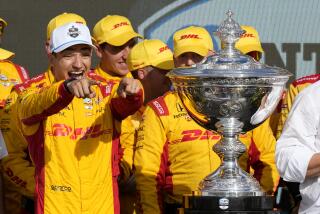Expert: Lap Belt Not to Blame
- Share via
Barry Myers, an independent medical expert appointed to view autopsy photos, reported Monday that stock car driver Dale Earnhardt had died of a basilar skull fracture caused by violent head whip and that a broken seat belt had not contributed to the injury.
Earnhardt, seven-time Winston Cup champion and NASCAR’s ranking star, was killed when his car hit the wall in the last turn on the last lap of the Daytona 500 Feb. 18.
His was the fourth such death in NASCAR racing in less than a year.
NASCAR blamed Earnhardt’s death on the broken seat belt.
Dr. Steve Bohannon, Daytona International Speedway’s director of emergency medical services, later speculated that Earnhardt’s basilar skull fracture was caused when his chin struck the steering wheel with great force.
Myers, a medical doctor with another doctorate in biomedical engineering, is a professor at Duke University. He discounted Bohannon’s theory in his report, concluding that although Earnhardt had hit the underside of his chin on the wheel, the violent forward motion of Earnhardt’s head caused the fracture.
“In other words, if Mr. Earnhardt did not hit his chin, he still could have suffered the same fatal injury in this crash,” Myers wrote in his report to John J. Upchurch, a court-appointed mediator in Daytona Beach, Fla.
Upchurch was appointed to mediate a dispute between Earnhardt’s widow, Teresa, and the Orlando Sentinel and other newspapers, including The Times, over Earnhardt’s autopsy photos. The papers wanted to determine precisely how the driver’s basilar skull fracture occurred.
Under Florida law, the photos were public record but Teresa Earnhardt, citing privacy concerns, went to court to have them suppressed.
In the legal settlement negotiated by Upchurch, Myers, with no ties to either side, was appointed to view the photos and report his findings. The photos were sealed after Myers had studied them.
In his report, Myers also contradicted the autopsy, which mentioned the basilar skull fracture but concluded that Earnhardt had died of blunt force head injuries--impact injuries.
Wrote Myers of the sequence, which he described as being “over in the blink of an eye”:
” . . . As a result of the crash, Mr. Earnhardt moved forward and slightly toward the right of the vehicle. This motion was opposed by his restraint system, the steering wheel and the other components of the vehicle interior. . . . As his chest and pelvis were stopped by the restraint system, his head began to follow a circular arc forward and down. Large inertial forces developed as the neck was stopping the forward motion of . . . the head. This is the basis of the whip mechanism which occurs in right side angled frontal collisions. In crashes like Mr. Earnhardt’s, these inertial forces alone can be large enough to produce ring fractures of the skull base.”
Later in the report, Myers wrote:
“Review of the vehicle photographs shows that the left [outboard] belt webbing is separated and appears torn. For the purposes of this analysis, I am assuming that the belt was torn as a result of crash forces as opposed to being cut following the crash. . . . The restraint system functioned to slow Mr. Earnhardt’s body. This includes the outboard lap belt for some significant portion of the crash. If the outboard lap belt had remained intact throughout the crash, Mr. Earnhardt’s head would still likely have experienced similar inertial forces and similar contact forces with the steering wheel. As such, the restraint failure does not appear to have played a role in Mr. Earnhardt’s fatal injury.”
Earlier Monday, NASCAR had conducted a teleconference, announcing an accident-reconstruction review into Earnhardt’s death. A review panel is to be made up of several experts in various crash reconstruction areas, among them one familiar with occupant-safety restraint analysis, the announcement said. Findings of the panel are not anticipated until at least August.
A spokesman read a statement from Mike Helton, NASCAR’s president. No questions were taken.
“Everyone involved in this process is committed to a sense of urgency, but we must also move forward in a thorough, careful and complete manner,” Helton’s statement said.
“We feel that only through a complete review . . . can we have a comprehensive understanding based on solid, factual information and data, even if it takes longer to obtain than we would like. . . .
“The review will require significant technical observations with each step being evaluated thoroughly and scientifically.
“Given the ‘building effect’ of the data gathered from each stage in the process, the results of this review will be reserved until its completion.”
In another development, Bill Simpson, the owner of the company that supplied Earnhardt’s seat belt said his business had suffered since NASCAR blamed the belt for Earnhardt’s death.
Simpson, speaking to the Orlando Sentinel, said the sanctioning body had offered no proof of the faulty seat belt. “I’ve been doing this for 43 years, and in one fell swoop, my reputation has gone to hell,” he said.
Simpson added that at least one racing team stopped using his firm’s safety products and that racing fans have sent him death and bomb threats.
He said he sent six sets of lap belts, made from the same batch as those in Earnhardt’s car, to an independent testing laboratory and that tests showed the restraints were able to withstand far more pressure than might be expected in a crash during a race.
During the test, he said, five of the belts failed when more than 4,750 pounds were placed on it. One did not fail, even under a load of 5,800 pounds.
John Melvin, a Detroit biomechanical engineer who consults with auto companies and racing circuits, told the Charlotte Observer the highest load he’d seen on a shoulder harness belt during crash tests was 2,000 pounds. A lap belt could experience more pressure, he said, but probably not as much as was put on them in Simpson’s tests. Simpson said he has yet to hear from NASCAR.
“I’ve never been told anything by anybody,” Simpson said. “All I know is what I read in the newspaper.”
*
The Associated Press contributed to this story.
More to Read
Go beyond the scoreboard
Get the latest on L.A.'s teams in the daily Sports Report newsletter.
You may occasionally receive promotional content from the Los Angeles Times.










